 Figure 1A. Human figure sculpture - Tonga.
Figure 1A. Human figure sculpture - Tonga. Figure 1B. Human figure sculpture - Rarotonga.
Figure 1B. Human figure sculpture - Rarotonga. Figure 1C. Human figure sculpture - New Zealand.
Figure 1C. Human figure sculpture - New Zealand.
Sculpture and Design: An Outline of Maori Art
By Gilbert Archey
Director, Auckland War Memorial Museum
2d ed. Handbook of the Auckland War Memorial Museum, 1960
Although this booklet purports to be "an outline of Maori art", it does not by any means cover all forms of Maori expression. Neglecting legend and chant, dancing, plaited textiles and painted scrolls, it limits itself to the art of wood-carving, and justification for the somewhat comprehensive sub-title appears only in the manner of approach to the subject.
I have previously written on: Maori Carving Patterns[1] discussing their place of origin and relationship - an ethnographical matter; here I invite you to consider Maori wood-carving as art. If it is an art we should expect to be able to recognize in it the influences that have borne upon the artist and the qualities that he aimed to achieve. We could note how he has observed natural objects, how he has chosen his material, with what skill he has won his purpose through it and with what discernment he has sensed the form value of a line, a curve or a surface. These are some of the qualities that constitute aesthetic essence, and by waiting upon them, by as it were looking at the individual craftsman in action and watching his themes unfold, we shall the better comprehend the art in his work; moreover, in contemplating its achievement as art we may even reach a truer understanding of the origin of its forms than through comparing and classifying the details of its patterns.
The question of origins is this: did the Maori carve in patterns and forms brought with him from the Tahiti-Cook Islands area or did he create, here in New Zealand, an art of his own? It bears upon the question to observe that, even in everyday articles of common use among the Maori, individu- ality asserts itself; and when we see in these, as we observe in carved houses, canoes and ceremonial objects, design expressing purpose with technical accomplishment fulfilling design in an achievement fit to stand in company with many another decorative art, do we not also see personal versatility, creative art, realizing itself, rather than mechanical reiteration of given design elements?
Also pertinent to the question of origins is the fact that Maori woodcarving still manifests today the starting point or the basic elements of its own development. It could do no other because it has, never lost its primary social purpose and inspiration. That purpose was commemoration, the perpetuation of the memory of tribal leaders and ancestors. So motivated, Maori art inevitably appeared as an art of the human figure, an art of statuary. It also became a complexity of involved designs. While these two, sculpture and decorative design, are the poles of Maori carving, they' are not poles apart and unrelated; there is, as we hope to show, a continuous theme of development between them, a theme that maintains a harmony of historic meaning with every nuance or variation of form.
Ancestors and leaders were held in honoured memory throughout Polynesia, and carved figures of gods and men, statues of one kind or other (Figs. 1a, b, c) were a feature of the art of every island group.
 Figure 1A. Human figure sculpture - Tonga.
Figure 1A. Human figure sculpture - Tonga.
 Figure 1B. Human figure sculpture - Rarotonga.
Figure 1B. Human figure sculpture - Rarotonga.
 Figure 1C. Human figure sculpture - New Zealand.
Figure 1C. Human figure sculpture - New Zealand.
The manner and style of these figures, and their size, vary in accordance with the materials and the tools available in each region. The dwarf hardwood figures of western Polynesia (la) stand in contrast to the more naturally-formed statues hewn from large soft-wood tree trunks in Hawaii, Rarotonga (1b) and New Zealand (lc). The stone sculptures of eastern Polynesia, of moderate size in the Marquesas, became broadly, indeed massively life-size in Raivavae, while in treeless Easter Island, where a soft volcanic rock was abundant, the enterprise of craftsman and chiefs, and their competitive ambition, produced the super-heroic statues for which not even the giant trees of the New Zealand forest, exploited to a degree though they were, could produce rivals.
 Figure 2 - Human figure house-post.
Figure 2 - Human figure house-post.
In Aotearoa - to give this country its Maori name - carved wooden figures, large and small, stood among the houses and along the palisades of every settlement. A characteristic of this free-standing sculpture is the large head and stiff attitude. It has been suggested that the head was made large because it was held particularly sacred among Polynesians; on the other hand the large size might have been the outcome of the carvers giving first (and consequently most) attention to the head, which in turn would still further limit the free disposal of the limbs within the already restrictive dimensions of a tree-trunk.
For whatever reason, Maori full-figure sculpture failed to express bodily freedom or activity; nevertheless his carving found other means, as we shall see, to manifest vigour and liveliness. Nor did Maori sculptures lack expression of features: calm serenity of portraiture (Plate 1a), strength or unrestrained defiance (Plate 1.b), in each case joined with a feeling for sculptural volume.
But the expression of sculptural form as such can hardly be claimed as an outstanding feature of Maori carving; its figures do not have the clean-hewn, dynamic quality of African sculpture, nor even of Hawaiian. The enterprise of Maori art explored another path; it joined company with the practical need in our temperate climate for warmer shelter than in tropical Oceania, and discovered a medium in the more solid house structure that developed here.
In his house-building the Maori found incentive and ready means for extensive portrayal of tribal history; this in turn gave him scope for developing his art. House posts were primarily houseposts; but when they were asked, as they invariably were, to be historic persons as well, natural representation had to yield to structural requirements. The challenge of applied sculpture had to be met, the figure to be absorbed into the shape of the post, lengthened and straightened to become and remain a housepost (Fig. 2) whereby the ancestor as well as the post supported the house practically, as together they upheld and sustained the community symbolically.
The requirements of applied sculpture could have been a restraining or limiting influence on figure ---sculpture, but not with the Maori; for them they became an opportunity and a stimulus for an enterprise that was to carry their wood-carvers forward into a richly diversified decorative art. For instance there are more planks than posts in Maori houses; planks provide room for the human figure to be widened (Fig. 3, a, b) and for its now broad features, limbs, shoulders, thighs, feet, to become areas for decoration.
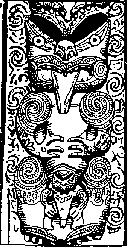
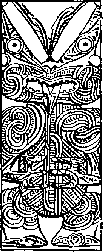 Fig. 3 - House planks, with broad figures in relief.
Fig. 3 - House planks, with broad figures in relief.
But they still combine structural and sculptural quality with commemorative purpose, as when Ngangaia and Matatahi (Fig. 4), ancestors of the Ngatimaru tribe, stand part of the wall of Ngatimaru's tribal meeting house, Hotunui; and with fifty other ancestors are at once the essential structure of the house, the history of the tribe and an integrative force within the community.

Fig. 4 - Ngangaia and Matatahi: ancestors of the Ngatimaru people and wall posts (poupou) of their meeting house Hotunui.
Most house figures stand square and steady, motionless as befits their structural function (Fig. 5); yet, as has been said, the Maori carver could manifest movement (Fig. 6). With liveliness came another quality, that of decorative design: the vigorous posture of the figure, the tilt of its head, the curve of the body and the disposal of the limbs, together absorb and express the form and proportions of the pataka gable plank. And does it not appear that the carver of Figure 7 was as much concerned with creating a design appropriate to his long plank as with commemorating his ancestor? Is there not, in the major sweep of the elongated head and lengthened body and the countervailing curve of the decoratively disposed limbs, a true feeling for smoothly moving rhythm? By way of contrast another carver, but from the same district, contains the human figure composedly within a long casket (Fig. 8), appropriately too, for it is a coffin; or, more precisely, a receptacle for the exhumed bones of a leader of distinction.
 Fig. 5 - Figure at base of house-post.
Fig. 5 - Figure at base of house-post.
 Fig. 6 - Gable end plank of pataka.
Fig. 6 - Gable end plank of pataka.
 Fig. 7 - House-plank from near Auckland; Wanganui Museum.
Fig. 7 - House-plank from near Auckland; Wanganui Museum.
 Fig. 8 - Mortuary chest; Hokianga district.
Fig. 8 - Mortuary chest; Hokianga district.
The Maori carver's controlled command over the human figure, in free sculpture or applied, thus led him from closely contained house-post figures, through the manifestation of movement, to a dominance of rhythm and design over natural representation. There are carvings that let sway a sinuous movement as in Figure 7; there are others in which the vigorous springing of the haka confronts us (Fig. 9) either with body facing front (9 a and b), part sideways or fully profile, all equally effective to convey an attitude or to become a design motive (9 d) standing in its own right or incorporated into a composite theme.
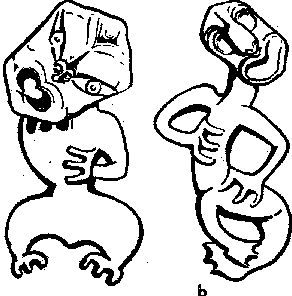
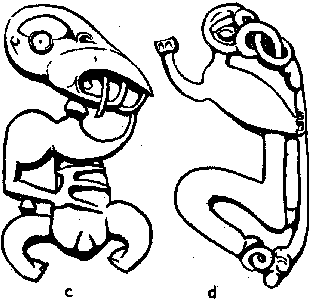
Fig. 9 - Relief figures expressing activity; all taken from intricate design compositions.
The head displays the same mobility of attitude (Fig. 10 a-f) though perhaps not of expression, for this has become somewhat fixed in the accepted stylization of the features. Like the body, the head faces front (10 a)., or turns sideways (10 b and c), becomes partly profile (d and e) or fully so (f); but, in turning, the features retain their stylized form, which inevitably results in the complete profile having a sharp, or beak-like mouth.
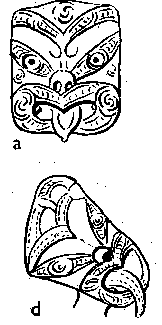
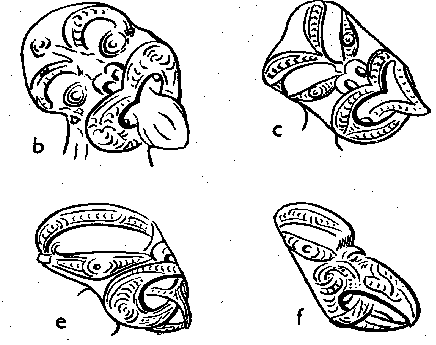
Figure 10 a-f: Masks, full-face to profile; from various compositions.
The search for the ethnographical relationships of Maori art has led some writers to interpret these profile faces as birds' heads, and to associate the resultant "bird-headed man" with the bird-man of Easter island, or of the Solomon Islands, or even with both, in spite of the distances separating them. But so patently are they -the outcome -of sheer artistic versatility within a convention, and of individual handling of flexible, though stylized, features, that it is less than justice to Maori carving to regard them as other than expressions of a lively personal art. That the profiles are indeed half an ordinary full-face can also be seen by covering one side of any such mask (Fig. 11 a-e), when every feature, including non-avian teeth, will be seen to contribute to the manaia face.
The idea of fixed design elements borrowed or brought here from other parts of the Pacific could not account for the intermediate positions involved in turning the head, except by postulating hybrid forms; in other words the native carver had twice been a mere copyist. Does it not seem more reasonable and satisfactory to credit the Maori artist with the simple desire, or the ability, to turn the human figure or face gradually sideways, or to cut the mask down the middle?
 Fig. 11 - a. Full-face mask; b. manaia one half of (a); c. to d. face-masks on canoe-bailer; e. manaia head i.e. left half of (d).
Fig. 11 - a. Full-face mask; b. manaia one half of (a); c. to d. face-masks on canoe-bailer; e. manaia head i.e. left half of (d).
Contorted figures with the face in profile are manaia (Fig. 12 a-c), as full face figures are tiki (Fig. 9 a-b); each having become stylized and decorative, their plastic possibilities could be exploited to the full. The whole figure could be simplified, perhaps lengthened (Fig. 12 d and e). Parts could be left out, though the whittling away was not haphazard; it was methodical, in the way of Hilaire Belloc's cautionary lion, proceeding from the feet up, but always leaving at least the head (Fig: 12 h-k).
The manaia face itself became a source of varied renderings. The gentle art of going one better, or further, saw the mouth increasingly drawn out and attenuated (Fig. 13 a to f) to fit a narrow space in a decorated slab.
Fig. 12 a.-k. Profile figures (manaia); details from various compositions.Click here to see image - 581Kb
Fig. 13 a.-f. Profile faces increasingly elongated as the particular design required; details from compositions.Click here to see image - 244Kb
Notice in these faces profiles the representation of tongue, or tooth, or both.
Another variation was to omit the lower lip, leaving room for the upper to curl downwards and around into a simple spiral (Fig. 14 b to e).
A further development was to link two mouths to form either simple interlocking loops (14 a), or a double spiral (14 f). In this last you will no doubt have observed the teeth and the tongue; that these are human faces becomes more apparent on turning the page to bring them upright.
 Fig. 14 - Profile faces forming sprals; a. interlocking mouths; b. to e. curled lip
single spiral; f. interlocking curled lips forming double spiral; notice the teeth in (a) and (f).
Fig. 14 - Profile faces forming sprals; a. interlocking mouths; b. to e. curled lip
single spiral; f. interlocking curled lips forming double spiral; notice the teeth in (a) and (f).
Our carvers did not remain content with devising stylized renderings of single figures; they revelled in complex compositions, many of them even more intricate than those the reader will have noticed in turning over the previous pages of photographic illustrations. The profile faces above (Figs. 13 and 14) are taken from such patterns.
Having now achieved the sculptures and stylizations we have been examining, our Maori carver has for his designs and compositions a full bench of ingredients of all degrees of simplicity and complexity; full figures of any form or stance, naturalistic faces or stylized masks, narrow or broad, full-face or profile with lips beak-like, curled or enspiralled, whole or part.
To the undiscerning the result is a disordered medley; but flow it ever so confusedly, its wantonness retains a civility of order and design. Let us then presume to he discerning, for there is a progression in its patterning that we can follow.
At the outset, in house building, where stability of structure and feeling called for steady full-face figures such as Ngangaia and Matatahi (Fig. 4, p.7) the serried rank of ancestors, each being separated from the other by reed-work (tukutuku) panels, escaped the monotony of uniformity. The Maori had better feeling, however, than to stand men in a row shoulder to shoulder all facing front. Having achieved the profile - the manaia - he used it with the tiki to express a simple, easy rhythm.
His basic or standard arrangement, when a long panel had to be decorated or a line of ancestors presented, was an alternation of full-face and profile figures (Pl. II, a): We see this rhythm of alternating attitudes on the paepae of meeting-houses and pataka (Pl. II, b) and on carved wash-strakes of canoes (Pl. II, c). But this was a theme - with variations, and where the variations became complex or involved, as they do in door lintels, or where representation surrenders almost wholly to design, the basic elements, though discernible, may have to be looked for. It may therefore be not without interest to follow the human figure theme in a few pare (i.e., doorlintel) compositions.
Those of the first group comprise human figures alone, full-face and profile, tiki and manaia. Fortunately we are able to introduce the type with an example in which the component figures are recognisable without difficulty (Fig. 15 and Pl. III, a), the more so in the print (Pl. III, b) from which the small connecting chocks have been blocked out. Here, then, on either side of the large central full-face figure (a), are a tall profile figure facing inward (b), a shorter full-face figure in lively attitude (c), a still smaller inward-facing manaia (d); sub-terminally a large manaia facing outward (e), its hand grasping the middle of the narrow band that represents the terminal figure ( f ).
Fig. 15.

f e
d
c b
a b
c d e
f
In another lintel of this type (Pl. III, c), design has asserted itself above representation to the extent that one needs to look even more closely at its loops and curves to clarify the stylized figures, especially the profiles, and to separate them (Pl. III, d and Fig. 15a) from one another and from the numerous small connecting chocks between them. Note again that this is a composition of alternating tiki and manaia alone, i.e. of human figures alternatively full-face and profile.
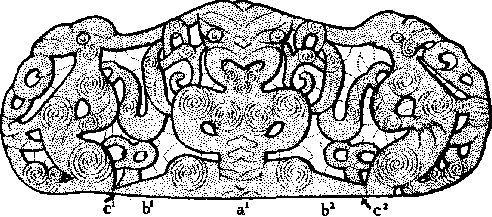
Fig. 15 and 15a. - Compositions of naturalistic and stylized human figures; door-lintels.
Compositions of this nature, based on human figures alone, could possibly have been the first design-achievement of Maori craftsmen; but this is an ethnographical question that we can well disregard as we linger for a moment to enjoy the agreeably flowing design before us and respond to its unique appeal. Unique it certainly is, or at least individual; for although the theme or content is known from several samples, no two of them are alike, while the intriguing variety among them and the complete and satisfying rhythm they express never fail to challenge our discernment as they stimulate our closer attention.
The Hauraki lintel (Fig. 16 and Pl. IV, b) exemplifies a second type of pare composition. A row of naturalistically carved figures dances against a background of tracery. But this is not all. At each end of the pare the figures are double, the customary opposed manaia, their mouths interlooped in a clearly intended decorative design. Close examination reveals that the background tracery- is composed of similar interlocking loops, some of them exact replicas of the enlooped mouths of the paired terminal manaia. Others, not so precisely the same, bear teeth which indicate their nature as mouths. These details taken together affirm, do they not, that the tracery components and the terminal looped mouths were to the carver one and the same thing?

Fig. 16 - Door-lintel composition - dancing figures against tracery of interloops.
It is appropriate here, before proceeding to the third type of pare, to examine two canoe prows. The first (Pl. V, a) has a terminal linked-mouth design, practically identical with the Hauraki form, and, as in Hauraki, this linked mouth is repeated 1n the background tracery. In. the second (Pl.. V, b) the terminal mouths form a clearly rendered double spiral, accompanied by interlocking spirals, not loops, in the tracery. The constant pairing of similar design elements in these door-lintel and canoe-prow compositions adds strength to the suggestion that, to the carver, they mean and are the same thing, and that interlocking loops as in the Hauraki background are indeed the beginnings of double spirals.

Fig. 17 - Composition of upright figures alternating with expanded double spirals. A door lintel.
The third type of lintel (Fig. 17 and Pl. IV, c, from Rotorua), with three full-face figures separated by large double spirals, is at first sight completely different from the Hauraki example. But here, too, a closer inspection discloses comparable features: notice in particular that there are, between the double spirals and alternating with them, reduced human figure elements, stylized full-face masks set sideways (Fig:18).


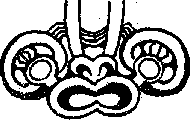
Fig. 18 - Stylized face masks between spirals in lintel patterns (a. from Pl. IV, C)
If then we find, in the Hauraki pare lively human figures alternating with incipient spirals; and in the Rotorua lintel steady full figures and reduced face masks alternating with now fully developed spirals, may we not find the difference between these schools to lie, not in their content which is the same in both, but in design emphasis. In other words, we are observing a personal art leaning; or preference, for figure rhythm in Hauraki and for spiral rhythm in Rotorua.
A fourth type of pare design (Pl. IV, d) is Taranaki's choice or experiment. It is a progression along the lintel of entwined sinuous human figures with their twisted arms and legs providing the subsidiary pattern. Taranaki also used a simplified form (Fig. 19) of the Hauraki lintel composition. They simplified canoe prows also in the same manner (Pl. VI, a).

Fig. 19 - Figures, spirals and interloops in a Taranaki door-lintel.
Our fifth door lintel, the Kaitaia carving (Fig. 20 and Pl. IV, a) has been the subject of much discussion. At first sight it appears to be non-Maori. Yet in consisting, as Dr. H. D. Skinner observed[2] when it was discovered thirty years ago, of "a central figure with a manaia figure facing outward, on either hand," it exhibits the same general design as in other types of pare. But the manaia were thought of as "bird-headed men" related to Easter Island figures; later they were reptiles, still with Easter Island affinities, while the other human figures, or parts of them, in the composition, remained unrecognised as such.

Fig. 20 - Chevron design; an abstraction from flexed limbs.
My own view is that in the Kaitaia carving we are looking at abstract art, at Maori abstract art, gone in the opposite direction to the Rotorua and other central North Island abstractions of linked-lip double spirals and reduced face elements.
The sensitively drawn-out chevrons are derived from limbs in a manner similar to that of certain well-known chevroned pendants (Fig. 21). When their limb derivation, i.e., their identification as abstract human figures, was first pointed out[3] , it was suggested that the pattern was an example of a simple angular stylization older than the curvilinear manner. But to attribute an early date to the chevron design seems unnecessary when we can so readily see in it just another enterprise in design by artist-craftsmen who knew quite well what they were doing. In any case the chevrons are not really angular or rectilinear; they are drawn out, abstracted, curved in a most graceful achievement, and we can clearly see their genesis in the arms of the dancing figures of Hauraki below them on Plate IV. (Cf. Archey loc. cit. p. 215).

Fig. 21 - Stylized limbs forming the "Chevron-pattern"; on whale-ivory pendant from Coromandel.
As to relative age: the Kaitaia and Hauraki lintels were each found in a swamp under circumstances similar to those of at least a dozen carvings (lintels, prows and sternposts in every style) and scores of other objects, i.e., implements, in in the Auckland Museum collections.
Depositing carvings in swamps or drains was a common practice, either for keeping the timber reasonably soft and less likely to crack during the long process of carving, or to hide them from enemies. Swamp yields are not necessarily of great age.
The Kaitaia design is therefore not to be regarded as an exotic type borrowed from afar; it is a creation of Maori art, as likely to be late as early, one of the five styles or schools that, in their divergent manner and in the quality of their renderings, attest both the versatility and the feeling for design of craftsmen conscious of their art.
As examples of decorative art, Maori canoe carvings would stand high in any company. A forward leaping human figure and two great spirals dominate the prow design (VI, b); but here again the spirals are separated by a stylized human figure in decorative openwork, and another backward looking human figure follows the second spiral. In the sternpost, taurapa (Pl. VII, b), expanding spirals and figure details, i.e., reduced manaia, follow alternately from base to crest in a climax of rhythm inevitably recalling the swirling wake of the canoe.
As a further reference to content, it may be remarked that, in stern posts, the manaia themselves look in alternate directions, which is what one would expect if the double spirals were themselves a pair of linked faces. In the trapezoid prows shown earlier (Plate V), the elongated sinuous profile figures separated by interloop tracery also face alternately in opposite directions, while in a small Taranaki prow (Pl. VI, a), the design, reduced though it is to three crude stiff figures spaced by wide open single loops, is fundamentally the same. In a way it links the trapezoid prow (Pl. V), to those with fully developed spirals (Pl. VI, b).
Those who look closely at the patterns of these prows and door lintels will, we feel sure, see in the Maori wood-carving tohunga (i.e. expert), not merely a craftsman competent with mallet and chisel, but a design artist deliberately planning his compositions and fully aware that the basis of his themes was the human figure. In the Hauraki pare the dancers are by no means unnatural in form or attitude; in Plate .III we see figures, some natural, others stylized, and others again as sheer design; in Hauraki an end-feature of interlooped mouths is repeated as a purely decorative device for the background; in the canoe-prows of Plate V the terminal interlocking mouths expand in the background into double spirals, spirals which in the Rotorua pareappear as an apparently independent abstract form, while in Kaitaia we see the designer taking but one element of human anatomy, the flexed limb, to create from it another, but altogether different abstraction.
It is not only that the nature of these pattern details reveals their origin; would you not agree that the overall unity and harmony of these compositions attests the clearly envisaged purpose and intention of their creators?
In the treasure box, waka huia (Pl. VIII, a and b), spirals large or small may be the whole composition except for the inevitable human figures, one at either end, which suspend the box and hold the design together. On the other hand, the northern people, Ngapuhi, favoured stylized human figures for waka huia (Pl. VIII, d), with subsidiary patterns of shallow spirals and loops decorating the body surface and limbs.
From the Waikato comes what we might regard as an intermediate manner of decoration (Pl. VIII, c). It is an all-over pattern of spirals, but they are small and shallow as in Northland, and the human figures that form the handles are of the sinuous entwined northern type.
Maori decorative art did not stop with the adornment of large objects such as we have been describing; practically every article the Maori made, in wood, bone, ivory or stone, received a measure of ornament, and whether we look at spades or weapons, or examine small boxes, musical instruments or the paraphernalia of practical pursuits we shall see the same design elements. If they are not unmistakable human features or limbs, they will be forms whose derivation from them is amply documented.
There remains to be considered a related endeavour of Maori art, one which, because of its nature - rock shelter drawing - is fairly well preserved and one which, as recent discoveries are revealing, has yet to disclose the full range of its achievement. The freedom of movement of the charred stick over smooth surfaces finds issue in a greater naturalism, but a naturalism salted with fancy and imagination.
Herbert Read has pointed out how child art, held in bounds by the limits of the sheet of paper, falls into design, which could suggest a source of design motive in surface carving on wood and stone. These rock drawings, untrammelled by dimensional restrictions, wander, range and extend as the variously curving surfaces invite, so that in general a quaint, misshapen naturalism prevails, as for example in a 16-foot "dragon" in a South Canterbury shelter. Elsewhere well established wood-carving designs are seen to have had their influence, i.e. in almost normal manaia, or in lizardlike forms with enlooped tails. Rock shelter drawing survived until recent times, particularly in North Otago and South Canterbury, with delineations of European sailing ships and houses; in one Waikato River rock face ( now destroyed by the Waipa hydro-electric construction) there are creatures that look like horses though their small size, if this is of any significance, suggests dogs. Travel seems to have been a favoured subject; there are several drawings of canoes with typical triangular sail, and sometimes with disproportionately large occupants.
If, as I hope, you now follow the theme presented in this outline, that Maori wood-carving, proceeding from sculpture to design, has derived all its patterns including chevrons and double-spirals from stylized human figures, you will find continued interest in discerning the ingenious variety in which they appear and in observing the competence of the designs achieved.
Apart from the acceptance of a convention or two, such as the face mask in which defiance became decoration, and the general style of full-face pou figures wherein sculpture conforms with structural -necessity, Maori carving is by no means stereotyped. It followed three or four styles or schools, but neither schools nor conventions were restrictions on the carver; rather were they means and opportunities, points of departure shall we say, for an enterprise and versatility that realized a wealth of design and decorative efflorescence.
Maori art is not a copyist art, borrowing and uninventive. Its command over basic elements and its pliant wielding of the forms it developed reveal that its craftsmen knew what they were doing and understood what they were using. Not only were different parts of the human figure selected as they might best suit the pattern, but they were also applied in different manner in different carvings - whole manaia, linked manaia (Fig. 9, d, p. 9; fig. 16, p. 16) (wrestling or embracing, who today knows which?) heads only, heads and arms, faces, masks in full or only eyes and lips: and all of this within any one school, with the manner of the stylization differing in each.
The human figure is never absent, except that a very rare reptile may stand alone, not as part of a design or composition[4] . One recalls here, however, the claim that the Kaitaia carving terminals are reptiles. But this view overlooks first, that mareaia may lean backward, stand upright or fall forward as the carver wills; secondly, that the mouth can be drawn out to even greater lengths than in Kaitaia; and thirdly, that the serrated teeth of Kaitaia are exactly reproduced in unmistakable human faces from the same Northland region.[5]
The human figure, moreover, almost invariably alternates with interlocked loops or with double spirals which in their simplest form are derived from human faces; here again we find repeated the basic rhythm of alternate tiki and manaia, the starting point of the path leading to intricacy and elaboration.
The whole body of Maori wood-carving reveals these vigorously exploited decorative forms, tiki (full-face) and manaia (profile), in all stages of development and variation. The range comprises free-standing commemorative statues; figures successfully incorporated into structural posts and pillars; broad house-planks providing room for the rendering of action in relief; panels portraying movement and posture which in turn gave the impulse for decoration and led to freely plastic design and pattern.
We affirm again, this is no copyist art: what we are regarding is not mechanical repetition of fixed patterns, but pliant abstractions, from one natural form, of design elements as intriguing in variety as they are apt in application. The content of the compositions is commemorative human figures; the forms expressed are an interplay of these same figures, in the rich effusion of Rotorua or the abstract simplicity of Kaitaia. Throughout this art there is the interest of unexpectedness, but, if I may borrow from Galsworthy, "an unexpectedness that still keeps to the mark of meaning," the meaning of notable events or personalities. This then is the nature of Maori carving: an art that runs the whole gamut of form-expression within the content of a single theme, the commemorative human figure.
The relationships of Maori carving are clearly Polynesian; they lie where one would expect to find them, in its basic element, in the human figure which, as statuary large or small, is common to all (Fig. 1). Some degree of patternising either from stylied human figures, or with figures in association with other elements is also found in Polynesia, simply rendered in Rarotonga (Fig. 22) and the Austral Islands (Fig. 23), and more complex in the Marquesas (Fig. 24); each has its own manner of patterning and doubtless its own history of design development.

Fig. 22 - A design composition (almost a pattern) of human figures; Cook Islands, possibly Rarotonga.

Fig. 23 - Decorative pattern of stylized human figures; Austral Islands
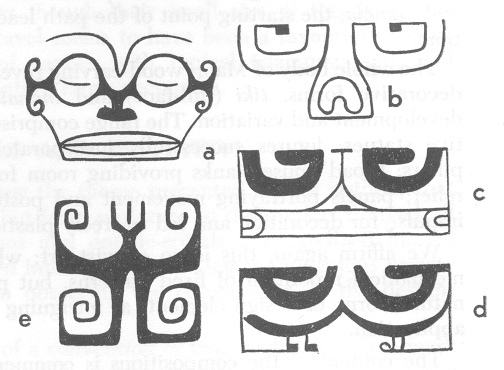
Fig. 24 - Marquesas Islands patterns - a. - d. human face; ( e ) whole figure with spiral limb endings.
As for the place of Maori art, it is scarcely necessary to excuse oneself of parochialism in claiming for it, not leadership in Polynesia, for it was isolated, but certainly pre-eminence. Its statues had dignity and sculptural quality, less awesome maybe than the aloof seaward gaze from Easter Island, but with a vigour primary and dynamic, while their versatile renderings in applied sculpture developed into an unparalleled richness and expressiveness of decorative design.
This is not to claim an equal status elsewhere for Maori art, for example alongside western art achievement. As native practices and custom, and the legend and tradition which exemplify them, can express a philosophy and ideals not yet consciously formulated, so native art can reveal principles of form and design, even such as are taught for guidance and inspiration in art schools, without their having been academically recognised by its craftsmen or formally stated. So with our Maori art: its content was narrative and descriptive like Maori legend and religion; its style and symbolism had grown and developed through a feeling for and a tacit acceptance of apprehended forms. In brief, it was a native art, but one possessed of a lively perception of natural form, together with technical competence and creative awareness.
One has but to look steadily at Maori art, in its lively figures and spinning spirals, its rhythmic undulations, its smooth abstractions, or the quiet shallow scrolls that express the shape of the bowl they decorate, to see the carver himself at work in his many moods. He knew what he was doing both in expressing content and meaning, and in winning his designs from what he wished to record.
Comment may be made here again on the view of Maori art which allies the manaia with the bird-headed man of Easter Island and of the Solomon Islands. Associated with it is the suggested derivation of the Maori double spiral from spirals in the Massim art of the Louisiade Archipelago near New Guinea.
As against the first view I present the fact that in each of the Pacific regions mentioned there was a ceremony or a religious belief that was both sanction and reason for portraying a bird-headed man, while there was nothing of the sort in either ceremony or tradition among the Maori.
The Easter Island figure depicted the 'bird-man' of the year, whose sponsored competitor had been the first to obtain, by swimming to a rocky islet, the egg of the sooty tern; in the Solomon Islands the frigate bird was highly regarded, among folk who depended greatly on fishing, as an outstandingly successful if somewhat lawless fisherman. The Maori had no reason for portraying a bird-man; moreover we have already seen a satisfactory derivation of the manaia within the body of Maori art itself.
Double spirals, not known at Easter or the Solomons, appear in Oceania only in the Marquesas Islands, some seven hundred miles north-east of Tahiti, and, as already mentioned, in the Massim area. In the latter a close spiral pattern is produced from the interlocking beaks of the frigate bird, but every stage in its development from quite naturally drawn heads appears in the local art. In the Marquesas, small single spirals result from extending the outline of an ear as local fashion presents it, or by curling the legs of insects or of man - again an obviously local art habit.
The difficulty encountered by those who would link Maori spirals with Massim is to find the route by which they had travelled. The Marquesas, where the spirals are single, not double, are remote from either place and many miles off any suggested migration route; spirals elsewhere in Oceania are conspicuously absent.
One wonders, therefore, what need there is to search for the supposed, `sunk without trace' path of the spiral across the South Pacific to New Zealand when, as with the manaia face, the stages of its local development are so readily evident.
The supporters of the overseas derivation of the spiral explain its absence from Polynesia by postulating a former curvilinear art there which had at some time disappeared through having been transmuted by some strong new rectilinear fashion', but of this there is no material evidence whatever.
Actually the human figure is to be seen in every art of Polynesia, both naturalistically rendered and either simply stylized or in patterns of obviously local development: The one item that is common to all Polynesian wood-carving is the human figure and a local pattern produced from it, and this is expectable in a region where forbears are everywhere commemorated and mythical ancestors have become gods.
If, then, we look at the arts of the several Polynesian island groups as they exist we shall not require any such difficult hypothesis to explain what is there. What we should see is the human figure in every group together with a local manner of stylization of the human form and in some cases also a decorative pattern based on the stylization. In other words the separate groups have independently pursued a line of art development from sculpture to design. This is by no means unusual; the same kind of progression can be seen the world over, in arts primitive or advanced.
The local evolution or development of its main design elements appears therefore to be amply documented within Maori art itself; but on this point it occurs to me that my earlier remark about a benchful of ingredients could have given quite the wrong idea by suggesting the picking up of a rnanaia here and an interloop there and fitting them together with an odd tiki or spiral in the manner of a jigsaw puzzle or a factory production line.
This, I maintain, is essentially the view of those who bring spirals or "birdmen" ready-made to New Zealand from the farthest boundaries of the South Pacific; whereas, to see the carver at work is to see the whole design grow in his mind out of the meanings he intended to convey, and to watch him, not pick up and apply, but create afresh every desired detail, each remaining a symbol of his meaning while becoming a form for his art.
Undoubtedly there was meaning in the arrangements that appear regularly in pare, pae-pae, prow or stern-post. Although what was portrayed or symbolized seems not to be recorded in tradition and legend, or we have missed it, we may be sure that the community at large understood the meaning as clearly as did the tohunga who wrought it. And as we today look into these compositions with some understanding of what they contained and of how the thoughts and ideas within them were expressed, we too may share in some measure the interest and enjoyment that the villagers and the tohunga alike experienced in Maori art at its richest and best.
When therefore we see Maori carving in this way, as the development and achievement of personal purpose and expression, we also see it standing naturally within the whole body of Maori arts. We see them all, carving and rafter painting, clothing and house textiles, the techniques of practical life, social ceremonial, dance, and the great record of tradition, legend and song, essentially Polynesian in origin, developing in Aotearoa through six centuries or more of robust response to the sterner conditions of an exciting new environment. In such a company of modes of expression it is small wonder that the Maori art of wood-carving was as vigorous as any one of them, and as vibrant and vital as the Maori people themselves.

Fig. 25 - The manaia-tiki-manaia rhythm on a canoe wash-strake rauawa.
| FOOTNOTES:
[1] Journal of the Polynesian Society, Vol. 42, 45; Records of the Auckland Institute and Museum, Vol.1. [2] Journal of the Polynesian Society, Vol.30. [3] Archey, G., Records of the Auckland Institute and Museum, Vol. 1, No. 4, 1933. [4] A row of naturalistic lizards adorns the ridge of the large modern (1868) pataka of Te Pokiha Taranui in the Auckland Museum. [5] Archey, G., Records of the Auckland Institute and Museum, Vol. 1, No. 4, Plate 45.
|